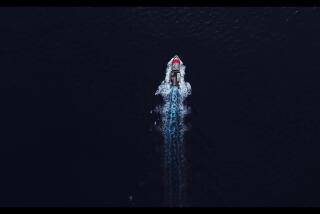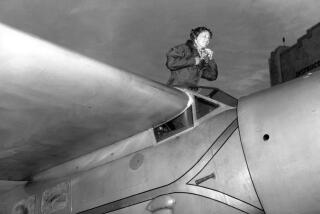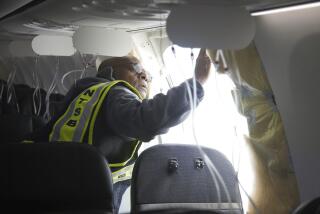A Theory That Won’t Fly? : East Coast experts say they solved the Amelia Earhart mystery. But a West Coast group thinks not.
SAN FRANCISCO — Richard Gillespie and his East Coast cluster of engineers and archeologists say they have found a patch of aluminum torn from Amelia Earhart’s airplane.
Mystery solved. Case closed. Conclusively, finally and overwhelmingly.
Yet Elgen Long and his West Coast clutch of mechanics and metallurgists say Gillespie’s artifact is fiction.
Not by any stretch of measurement or the imagination, they claim, could the piece be from Earhart’s airplane. The case remains wide open. Absolutely, unanimously and positively.
“Any engineer acquainted with basic aircraft structure . . . could tell you that the Nikumaroro fragment did not come from a Lockheed 10 aircraft,” says Long, 65, a 20-year sleuth of the short life, public times and final flight of Earhart.
Spacing between rivets doesn’t match. Nor does the distance between horizontal lines of rivets. A vertical line of fasteners that should be on the fragment simply isn’t there.
“But for the umpteenth time we have The Final Solution of Amelia Earhart,” Long says, sarcastically. “Why isn’t anyone listening to us? Because we’ve only got boring mechanical reasons on our side and they just aren’t nice sound bites.”
There were sound bites by the thousands and worldwide earlier this month when aviation researcher Gillespie told a mobbed Washington news conference that he had unraveled the 55-year-old enigma of Earhart’s end.
What Gillespie didn’t announce was that he had asked Long last month to examine the 23-by-19-inch shard recovered in October from Nikumaroro Island in the central Pacific.
Long, a retired airline captain, was briefed by two letters, one with pages stamped Confidential. It described the piece’s dimensions, outline, markings and rivet patterns in sufficient detail to build a clear plastic template of the fragment.
Gillespie, executive director of the Delaware-based International Group for Historic Aircraft Recovery (TIGHAR), wrote: “ . . . the only match found is to a section on the starboard belly of NR16020 (Earhart’s twin-engined Lockheed Electra 10E) between fuselage stations 239 (inches from the nose) and 269 5/8 along the aircraft’s center line on keel. . . .
“I look forward to your thoughts on all this.”
Long recruited a formidable panel of volunteers: a professor of metals engineering; a structures engineer for Navy patrol aircraft; the owner of two Lockheed 10 airplanes, and the assistant foreman, now retired, of the Lockheed fuselage shop at the time Earhart’s plane was built.
The group pored over photographs of the piece. They examined blueprints and engineering orders for repairs to the airplane’s underside needed after a takeoff accident ended an earlier Earhart attempt to fly around the world.
And the team visited a 1936 Lockheed 10B at Oakland’s Western Aerospace Museum.
The associates placed the template over the starboard belly of the airplane. They slid the piece over all other exterior sections of the airplane. Just in case.
“We decided the fragment could have come from anywhere . . . anywhere but Amelia Earhart’s airplane,” Long says.
So noted the group’s formal report--including a videotape of comparisons to the underside of the museum aircraft--sent to Gillespie in February.
But Gillespie, a 45-year-old former insurance investigator turned aviation archeologist, made no mention of the negative findings during his March 16 news conference at the National Press Club.
Instead, he announced that his own nonprofit group of largely lay historians and aviation detectives had “recovered artifacts that conclusively prove this case.”
He displayed the aluminum fragment. Also a Cat’s Paw rubber heel that Gillespie said belonged to a woman’s shoe. Other beach combings from Nikumaroro--once known as Gardner Island and a British colony--included a portion of a sole presumed to be from the same shoe, a length of copper antenna wire and a bottle cap that might have contained a patent medicine.
Concurrent to his conference, Gillespie wrote an article for Life magazine. The story was accompanied by four paragraphs of rebuttal--added, says a Life editor, at the magazine’s insistence--from Frank Schelling, a structures engineer with the Naval Aviation Depot, Alameda, and chairman of Long’s committee.
The rest of Gillespie’s article, however, left few doubts unsquashed.
He said a metallurgist from the National Transportation Safety Board, the U.S. agency responsible for investigating all aircraft accidents, had told him: “Looks like you’ve got it nailed.”
The metal certainly checked out as .032-inch aircraft aluminum made by Alclad prior to World War II--identical to the skin of Earhart’s Lockheed. A rivet attached to the metal was of ‘30s vintage--and of the type used by Lockheed when building Earhart’s plane.
The rubber heel, said Gillespie, has been examined by officials from Biltrite Corp. of Waltham, Mass., makers of Cat’s Paw footwear since the 1900s. It appeared to be from a Size 9 woman’s shoe, was definitely of pre-World War II construction and would fit the style of lace-up Oxfords worn by Earhart on her last flight.
“Every possibility has been checked, every alternative eliminated,” Gillespie announced. Eureka. “There is only one possible conclusion: We found a piece of Amelia Earhart’s aircraft.”
Within minutes, Earhart was again playing Page 1 and top of the news around the world.
Just the way it was on July 2, 1937.
Earhart, 39, a record-smashing aviator and pioneer feminist, had taken off from Lae, New Guinea. With Fred Noonan riding as navigator, their Lockheed 10E was on a final leg of a circumnavigation that would earn yet another record for the tomboy flier.
Twenty hours and 2,500 miles later, Earhart radioed a Coast Guard cutter moored near Howland Island, site of the next landing. She said she should be approaching the island but couldn’t see it.
Her signal strength told radio operators aboard ship that Earhart was close. She said her fuel was down to 30 minutes. Then, silence.
In the half-century since, a hundred theories have enlarged the persons and their journey into a significance far greater than had the flight succeeded.
Did Earhart--as researcher Long believes--crash in the sea and drown near Howland?
Did she and Noonan--as broadcaster and Earhart author Fred Goerner thinks--land on nearby Saipan, only to be executed as American spies by the Japanese?
Was Earhart--as other biographers have claimed--taken to Japan and then smuggled back to the United States at war’s end to lead a new life under an assumed identity?
Or did she--as Gillespie believes--miss Howland and fly 350 miles southeast to Nikumaroro?
There, Gillespie theorizes, the couple crash-landed on a reef but died of thirst a few days later. A storm washed the Lockheed off the coral beach and into deep water. But one piece of aluminum, a belly portion, remained buried in the sand to be revealed by a vicious storm 50 years later.
Gillespie has spent $750,000 in private donations on two trips to Nikumaroro. His first findings were false alarms.
A grave that might have been Earhart’s contained the bones of a native child. A cigarette lighter that could have belonged to Noonan was probably lost by one of dozens of Coast Guardsmen who manned a radio station on Nikumaroro during World War II. A navigator’s chart box thought to have been from Earhart’s Electra was finally identified as equipment from a military airplane.
And a deep-water sonar search found no trace of Earhart’s airplane in the sea surrounding Nikumaroro.
Now, in a bicoastal war of experts, critics are shredding Gillespie’s latest clues.
They have not zeroed in on the bottle cap and other fragments believed inconsequential. They have focused on the aluminum fragment and the Cat’s Paw heel.
One of Gillespie’s experts, William Foshage Jr., president of the Biltrite footwear division, said the heel was made before 1940 and was “the same type of heel, basically,” as that worn by Earhart.
But in an interview with The Times, Foshage acknowledged that this Cat’s Paw heel was unisex: “It could have been on a man’s shoe.”
Foshage agrees the rubber heel would have fit a Size 9 shoe. But according to Earhart’s sister, Muriel Morrisey, who lives in New Medford, Mass., the flier had tiny, narrow feet and wore a Size 6. That size was confirmed by the curator of an Amelia Earhart museum in Atchison, Kan.
Nikumaroro has been visited by thousands since colonization in 1938. First copra traders and Gilbert Islanders. Then U.S. military and resupply teams.
So the shoe could have been dumped by anyone. Or simply washed ashore.
But it is the metal piece, say Long’s experts, that completely corrodes Gillespie’s conclusions. When contrasted with airplane plans and the Oakland museum’s Lockheed 10B, the fragment fails in cardinal areas:
* Rivet holes on the recovered aluminum are one inch apart. On Earhart’s airplane the separation was 1 1/2 inches.
* The fragment shows four lines where the panel was riveted to stringers, or horizontal fuselage braces. They are 4 1/4 inches apart. On surviving Lockheed 10Bs, the lines are 3 1/2 inches apart.
* The aluminum skin of a Lockheed 10 is formed around ribs, or stiffeners, 15 inches apart. On the fragment--which is almost 24 inches long--there is no vertical line to show that the metal was ever riveted to a stiffener.
* Gillespie says a tab protruding from an edge of the fragment marks where the sheet was riveted to the I-beam forming the keel, or center line, of Earhart’s airplane. That tab shows a single line of rivet holes. Yet on the Lockheed 10, says Long, center line panels would be held by a double line of rivets and in a staggered pattern for additional strength.
Long’s team does not dispute that Gillespie’s artifact is made of Alclad aluminum from an aircraft built in the ‘30s. They also know that during World War II, military aircraft built in the ‘30s--such as the PBY Catalina--flew that particular patch of the Pacific and visited Nikumaroro.
Ernest Zehms, 70, a retired materials engineer from Woodland Hills, was a Coast Guard petty officer stationed on Nikumaroro from 1944 to 1945.
“We had a radio technician who used to fly back to the island with things he had scrounged,” Zehms says. “Some of it was aluminum, flat stock, Alclad. It had been cut out of the wing or fuselage of a B-25 that had gone off the end of the runway on Kanton Island.”
Gillespie acknowledges that his experts and Long’s experts are locked in “a great debate on the unknowable. . . .”
Gillespie says his evidence is based on “the knowable, contemporaneous records and hard evidence in the form of artifacts that we can measure.” That translates to the age and gauge of aluminum, its obvious use as aircraft skin, a failure pattern apparently consistent with crash-landing and other facets.
He says Long’s evidence is “based on opinions,” and when his group first reported a verdict on the fragment, “I was disappointed to hear him (Long) make pronouncements that were not true.”
Gillespie sees no mystery in variances of rivet spacing and patterns. He believes the positioning was changed when Earhart’s plane was repaired after the takeoff accident.
Not so, insists Ed Werner, 82, of Santa Cruz, the assistant foreman of Lockheed’s fuselage shop at Burbank at the time.
The rivet patterns on the fragment, he says, “just don’t follow the engineering orders for the repairs. If those orders weren’t followed, the repair couldn’t have passed inspection and the airplane wouldn’t have been released. And no double riveting along the center line . . . is tampering with the structural integrity of the airplane.”
Harvey Christen, 81, of Pasadena agrees. A retired director of quality reliability for Lockheed, Christen was Werner’s boss during repairs to the Earhart plane.
“Nobody repaired anything at Lockheed without taking it back to its original configuration, as dictated by the airplane’s federal certification,” he says. Under such rigid controls, it would be “unthinkable” that any worker or inspector would allow a repair where the riveting missed a complete line of attachment to a fuselage stiffener.
Gillespie believes his fragment should have never been compared to a Lockheed 10B because Earhart was flying a Lockheed 10E.
Nonsense, says Fred Patterson of Mill Valley, Calif., a World Airways captain who owns two Lockheed 10Bs and is rebuilding a 10E:
“The only differences between a 10B and a 10E have to do with engines and window positioning. There are 12 Lockheed 10s in existence. I’ve seen all of them. And the fuselages, the rivet patterns, the spacings between stringers and stiffeners, are identical.”
A large portion of Gillespie’s case hangs on a report of the National Transportation Safety Board.
In his news conference, Gillespie said the federal agency was unable to prove that the metal did not come from Earhart’s airplane. The implication here is obvious. In his Life article, Gillespie quotes the author of the NTSB report, Joe Epperson, a senior metallurgist, as commenting: “Looks like you’ve got it nailed.”
But Epperson’s seven-page report draws no conclusions beyond establishing that the fragment is a piece of old, fractured airplane aluminum with rivet holes. It does not state that the agency was unable to prove the fragment did not come from Earhart’s airplane.
Is Gillespie drawing a convenient conclusion from the unsaid?
“Every one of these (NTSB examiners) are convinced that this piece of metal is from Amelia Earhart’s airplane,” Gillespie says. “Epperson said to me: ‘That’s a piece of Amelia Earhart’s airplane.’ ”
(Epperson did not respond to several telephone messages. Gillespie agreed to ask Epperson to call The Times to confirm his private statements, but no call has been received.)
But an NTSB spokesman says conclusions credited to the report were not drawn by the board.
“If it were our investigation, going from A to Z, we would not be drawing such hard and fast conclusions on the basis of the evidence shown us,” he states. “We don’t jump from A to Z without looking at the 24 points in between.”
Meanwhile, Gillespie and his organization are not budging.
He says he can now stand before the world with the final answer to the Earhart mystery and “defend that to any rational person.”
But not to Elgen Long.
Long wants the fragment studied “conclusively” by the NTSB or the Smithsonian Institution. He also wants to form an expedition to follow his own theory that the airplane is in 16,000 feet of water off Howland Island.
“Eventually the hype and media will get out of the way, and rational, independent experts will study it and the truth will sort itself out,” Long says.
“But then, like J.F.K., someone will come up with a conspiracy theory.”
More to Read
Sign up for Essential California
The most important California stories and recommendations in your inbox every morning.
You may occasionally receive promotional content from the Los Angeles Times.










